Dragonflies are among the most entertaining insects to watch. They are large, easy to find near wetlands, and they move quickly as they hunt for good. Furthermore, they are incredible mosquito control and we owe them for their service! But did you know that there’s a lot more to these fascinating bugs than meets the eye? Check out these amazing facts about dragonflies!
1. They are not actually flies
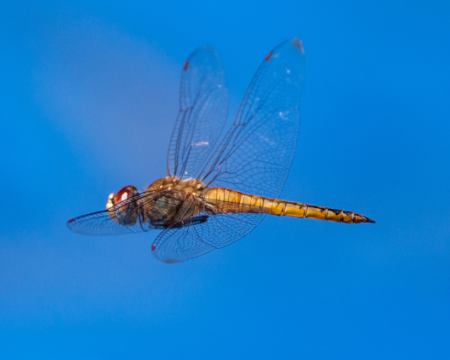
Wildlife names can be deceiving, and dragonflies are no exception. While they have “fly” in their name, they don’t belong to the insect order Diptera, (“two-wings”), the true flies. Instead, dragonflies belong to the order Odonata (roughly, “the toothy ones”). Specifically, dragonflies make up the sub-order Anisoptera (“uneven-wings”), as opposed to their cousins the damselflies or Zygoptera (“paired-wings”).
2. They are among the world’s best fliers
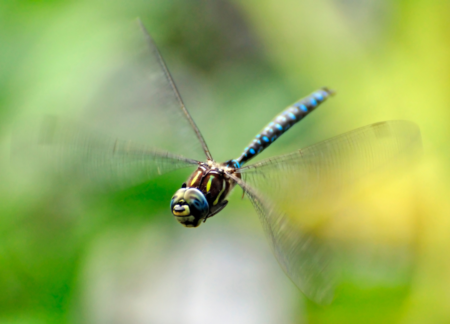
Dragonflies can do a lot with those “uneven wings”. One of the first things people notice about them is their two pairs of wings, with the front pair slightly larger than the back. Importantly, dragonflies are able to move these four wings independently. This gives them incredible control over their bodies in the air.
Because of this control, dragonflies can move in almost any direction (up-down, back-forward, right-left), and hover in mid-air. Furthermore, some can reach speeds of up to 35mph (~56km/h), making them the world’s fastest insect fliers.
3. Dragonflies are hyper-effective predators

They’ve got to have all that horsepower for a reason, right? Importantly, dragonflies are predatory insects, meaning that they feed on other animals to survive. With their incredible flying abilities, they chase down airborne insect prey. Next, they capture their prey by using their legs like a basket. After they have captured their prey, they can even eat it in mid-air!
Dragonflies’ incredible eyesight (see fact #9 below!), matched with their speed, makes them formidable predators. According to one study, closely monitored dragonflies successfully nabbed their prey on 80-90% of attempts. That’s way better than big predators like tigers or wolves, which are successful maybe 10-20% of the time.
4. They spend most of their lives underwater
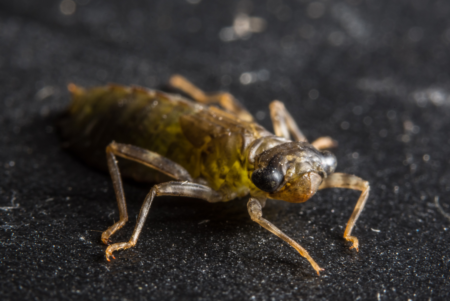
Here’s one of the most unexpected facts about dragonflies. While we get to enjoy dragonflies in warmer weather, they don’t spend much of their time as flying hunters. In fact, all dragonflies spend the majority of their lives living underwater. Baby dragonflies, called nymphs or naiads, are fully aquatic.
Dragonfly nymphs start as tiny, wingless, brown little bugs with gills to breathe underwater. They are aggressive ambush predators, hiding in vegetation and grabbing anything smaller than them. Their voracious diets are what allows them to go from tiny naiads to big, beautiful, winged adults.
However, all of that growth takes time! Many dragonfly species will spend several years (sometimes up to 5!) living their underwater lifestyle. Depending on the length of the growing season, they may need more time to grow large enough to metamorphose. By contrast, dragonflies in their adult form don’t tend to persist for more than a year or two and typically only last for a single mating season.
5. Dragonfly nymphs jet-propel themselves with their butts
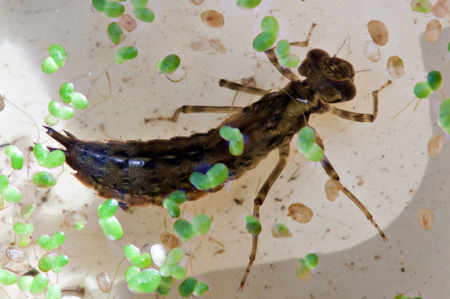
Yeah, you read that right. While naiads are happy to creep up on prey using their legs, escaping underwater predators is another matter. When a baby dragonfly needs to get a move-on quick, they shoot water out of their butts. This jet propulsion system can shoot them through the water when a little speed is needed.
6. They have anti-bacterial wings
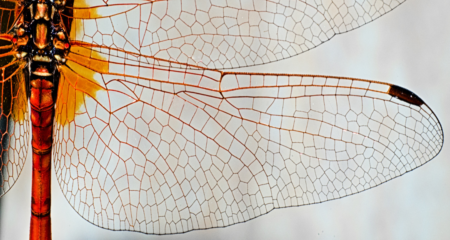
A fascinating study published in the American Chemistry Society revealed one of the strangest facts about dragonflies. Specifically, researchers used hyper-sensitive microscopes to examine dragonfly wings, and found that they have incredible anti-bacterial properties. Furthermore, these properties didn’t come from any sort of chemical that the dragonflies produced. Instead, they came from tiny spikes called “nano-pillars” that texture the wing’s surface.
The same microscopic forces that help bugs stick to walls also make these nano-pillars a sticky obstacle for bacteria and other microbes. When harmful bacteria like E. coli contacted the wings, they became stuck to the nano-pillars. Because of this, if they tried to move or shift along the wing’s surface, they would damage their “skin”. Such damage to the cell wall can be fatal to bacteria. Scientists are now investigating how to mimic dragonfly wings to make antibacterial surfaces for humans.
7. Mating dragonflies form a heart shape
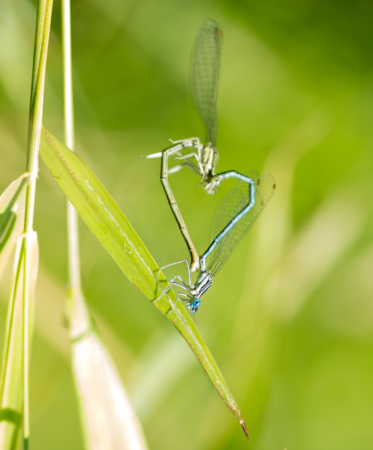
Mating is a pretty complicated (and sometimes not very sweet) affair for dragonflies. But part of how it’s done looks particularly romantic to our human eyes. Adorably, mating dragonflies in what is called the wheel position can form a heart while attached to one another.
This mating position occurs when the male has clasped the female’s head with little claws on the end of his abdomen (called the cerci and epiproct). At the same time, she has attached the bottom of her abdomen to his body to receive transferred sperm.
If the pair wants to move around while attached this way, the male may lift up his abdomen, allowing the female to rest horizontally behind him. This lets them both flap their wings and fly together as they continue mating!
8. Some dragonfly species migrate

Many animals migrate to warmer locales during winter. However, insects are not typically one of them. While many insects have ingenious ways of escaping the cold, they often can’t move far enough to migrate. Master-flier dragonflies don’t have this issue, so some species are highly migratory.
Generally, migratory dragonflies tend to be larger species. They move Southward when cold fronts come in during the Fall, and Northward in the Spring. However, some species will even migrate across oceans! A study on a species called the Globe skimmer (Pantala flavescens) suggested that they can migrate as far as 11,000 miles (~18,000km) nonstop!
9. Their heads are covered in thousands of “eyes”
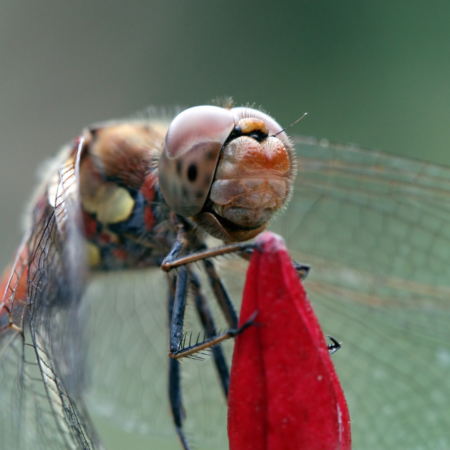
One of the most recognizable things about dragonflies is that their big heads are almost entirely eye. Their two large compound eyes are made up thousands of tiny facets that can all see independently. There are somewhere around 28,000 of them, to be exact. These many ommatidia give dragonflies highly accurate vision in almost 360 degrees.
This not only makes them excellent hunters, but it means it can be a challenge to catch them, too!
10. Some dragonflies can change color
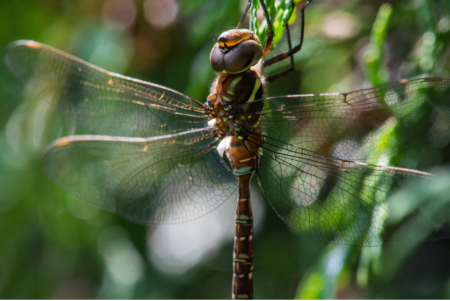
Insects are generally ectothermic, which means that their body temperature depends on outside temperatures. Ectothermic animals need to find special strategies to regulate their temperatures. Some dragonflies in the Darner family (Aeshnidae) can do this by changing colors.
Specifically, they can control the orientation and position of reflective granules in their skin. By moving these closer to the surface or further away, they can change how dark or reflective their bodies are. In turn, this affects how much solar heat they absorb and can help them cool down or warm up.
11. Dragonflies have three typical hunting strategies

Dragonflies have a variety of lifestyles and are found in many habitats as long as they have water. Naturalists divide most dragonflies into three groups depending on how they make a living through hunting:
- Fliers patrol a three-dimensional airspace for airborne prey. They often defend these airspaces as a feeding or mating territory.
- Cruisers are wanderers that fly long distances looking for prey. They are often spotted far outside of wetland habitats, like over meadows or sports fields. These are typically among the largest dragonflies.
- Perchers sit on a rock, branch, or leaf with good visibility, and look out for passing prey. They sally out and grab any prey that comes within range, then head back to their perch to wait for the next meal. Perchers often defend a feeding territory around their favorite little sit-spot.
14. Female dragonflies have clever egg-laying strategies
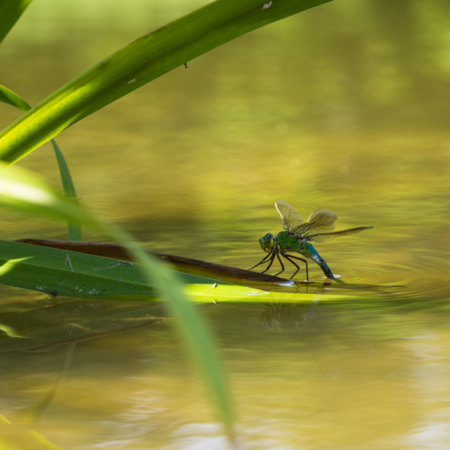
Airborne mama dragonflies have to get their eggs into the water for their aquatic young to survive. Fortunately, they have developed some fascinating strategies to make that work. For example, some darners have sharp blade-like appendages on their abdomens. They use these to cut a hole in the stems of aquatic vegetation and lay eggs inside. When they hatch, the young can drop easily into the water.
Other species will lay their eggs on moist moss or lichens near a wetland, and let heavy rainfall wash the eggs into the water. Skimmers (family Libellulidae) just toss their eggs from the air straight down into the water!
15. They are living fossils
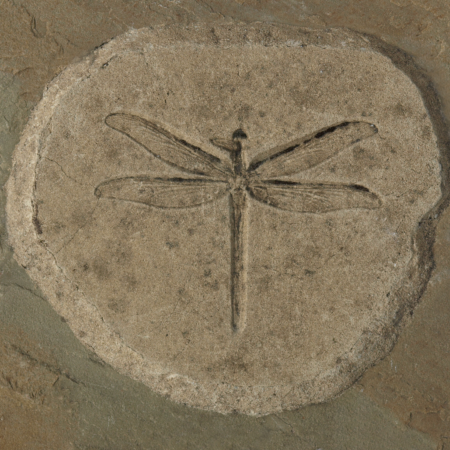
Dragonflies are ancient animals. So ancient, in fact, that they were around before the dinosaurs. While the earliest fossil evidence of dinosaurs is from around 240 million years ago, dragonflies show up in the fossil record more than 300 million years ago.
That means that for 60 million years, almost as long as it’s been since the last dinosaurs went extinct, dragonflies flew through the air with no dinosaurs below.
16. Dragonflies can’t fold their wings like other insects
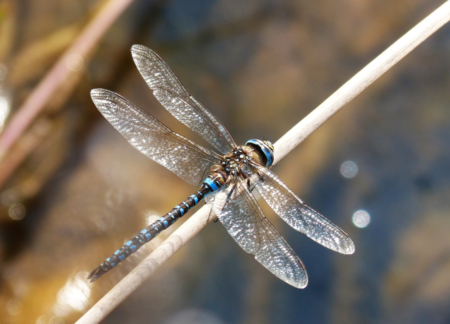
Dragonflies’ two pairs of huge, independent wings actually show their age. That is, they prove that dragonflies are an ancient group of insects, while more modern orders often appear to have only two wings. Those big-honking wings are a little inconvenient, and dragonflies can’t actually fold them up the way that other species can. Accordingly, dragonflies are called paleopterous or “old-winged”.
Call ’em old-fashioned, I guess!
17. Their babies have mouths like the Xenomorphs from Alien
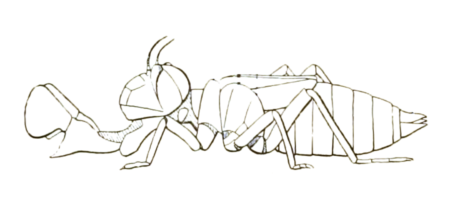
I’ve saved the scariest facts about dragonflies for last. This one is a candidate for my post on scariest nature facts. While adult dragonflies are excellent hunters, their young naiads are no exception. These intense ambush predators will hunt all kinds of underwater prey, including small fish!
A dragonfly nymph’s lower lip is a clawed “arm” that they can shoot out and seize prey. It’s a lot like the creepy “second mouth” that the creatures from Alien eat people with. This special appendage can be up to one-third the length of the nymph’s body. Even scarier, it can shoot out in 0.01 seconds to seize prey! Now if that’s not nightmare fuel, I don’t know what is.
More sources for facts about dragonflies
Looking for more facts about dragonflies? Check out these titles for further reading:
Thanks for reading facts about dragonflies!
Have you seen some cool dragonflies lately? What are your favorite facts about dragonflies? Share with us in the comments! If you’ve got an idea for the next Wildlife Spotlight post, send a message using the Contact form.

